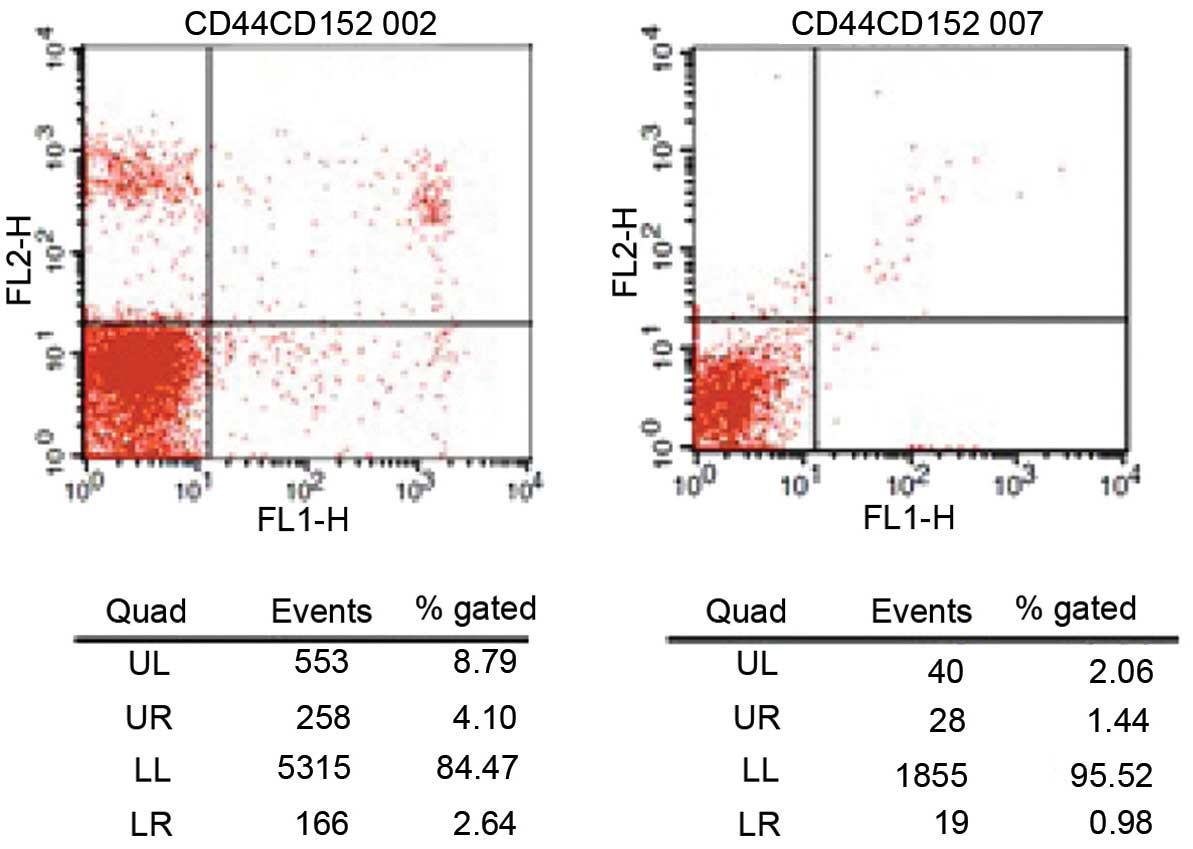|
1
|
Ravelli A and Martini A: Juvenile
idiopathic arthritis. Lancet. 369:767–778. 2007. View Article : Google Scholar : PubMed/NCBI
|
|
2
|
Thierry S, Fautrel B, Lemelle I and
Guillemin F: Prevalence and incidence of juvenile idiopathic
arthritis: a systematic review. Joint Bone Spine. 81:112–117. 2014.
View Article : Google Scholar : PubMed/NCBI
|
|
3
|
Tugal-Tutkun I, Quartier P and Bodaghi B:
Disease of the year: juvenile idiopathic arthritis-associated
uveitis – classification and diagnostic approach. Ocul Immunol
Inflamm. 22:56–63. 2014. View Article : Google Scholar : PubMed/NCBI
|
|
4
|
Vastert SJ, Kuis W and Grom AA: Systemic
JIA: new developments in the understanding of the pathophysiology
and therapy. Best Pract Res Clin Rheumatol. 23:655–664. 2009.
View Article : Google Scholar : PubMed/NCBI
|
|
5
|
Nusman CM, van den Berg JM,
Schonenberg-Meinema D, et al: Juvenile idiopathic arthritis: from
biomarker to treatment. Ned Tijdschr Geneeskd. 157:A63912013.[(In
Dutch)]. PubMed/NCBI
|
|
6
|
Goldzweig O and Hashkes PJ: Abatacept in
the treatment of polyarticular JIA: development, clinical utility,
and place in therapy. Drug Des Devel Ther. 5:61–70. 2011.PubMed/NCBI
|
|
7
|
Carreno BM and Collins M: The B7 family of
ligands and its receptors: new pathways for costimulation and
inhibition of immune responses. Ann Rev Immunol. 20:29–53. 2002.
View Article : Google Scholar
|
|
8
|
McCoy KD and Le Gros G: The role of CTLA-4
in the regulation of T cell immune responses. Immunol Cell Biol.
77:1–10. 1999. View Article : Google Scholar : PubMed/NCBI
|
|
9
|
Pediatric Rheumatology Collaborative Study
Group in China: Diagnosis and treatment of pediatric rheumatic
diseases: a consensus statement (I). Lin Chuang Er Ke Za Zhi.
28:984–991. 2010.[(In Chinese)].
|
|
10
|
He XZ: Juvenile idiopathic arthritis.
Edmonton, Canada, 2001 (Draft for new classification standard for
International Society of Rheumatology). Zhonghua Feng Shi Bing Xue
Za Zhi. 6:62–63. 2002.[(In Chinese)].
|
|
11
|
Hu YM and Jiang ZF: Zhu Futang Practical
Pediatrics. 7th. People's Medical Publishing House; Beijing: pp.
667–672. 2002
|
|
12
|
Grom AA and Hirsch R: T-cell and T-cell
receptor abnormalities in the immunopathogenesis of juvenile
rheumatoid arthritis. Curr Opin Rheumatol. 12:420–424. 2000.
View Article : Google Scholar : PubMed/NCBI
|
|
13
|
Wang LL, Li LX, Liu Z and Feng WH:
Relationship between disequilibrium of T lymphocyte subgroups and
inflammatory adhesion molecules in patients with rheumatoid
arthritis. Mian Yi Xue Za Zhi. 18:378–380. 2002.[(In Chinese)].
|
|
14
|
Li YJ and Dong WL: The last advances of
study on the B7 family members. Guo Ji Mian Yi Xue Za Zhi.
34:221–226. 2011.[(In Chinese)].
|
|
15
|
Goëb V, Buch MH, Vital EM and Emery P:
Costimulation blockade in rheumatic diseases: where we are? Curr
Opin Rheumatol. 21:244–250. 2009. View Article : Google Scholar : PubMed/NCBI
|
|
16
|
Rodríguez-Palmero M, Franch A, Castell M,
et al: Effective treatment of adjuvant arthritis with a stimulatory
CD28-specific monoclonal antibody. J Rheumatol. 33:110–118.
2006.PubMed/NCBI
|
|
17
|
Qi JJ, Zhang P and Xiong XH: Relationship
between abnormality of costimulative molecular expression and
imbalanced immune function in patients with rheumatoid arthritis.
Lin Chuang Hui Cui. 22:174–176. 2007.[(In Chinese)].
|
|
18
|
Brunet JF, Denizot F, Luciani MF, et al: A
new member of the immunoglobulin superfamily – CTLA-4. Nature.
328:267–270. 1987. View
Article : Google Scholar : PubMed/NCBI
|
|
19
|
Chang TT, Kuchroo VK and Sharp AH: Role of
the B7-CD28/CTLA-4 pathway in autoimmune disease. Curr Dir
Autoimmun. 5:113–130. 2002. View Article : Google Scholar : PubMed/NCBI
|
|
20
|
Linsley PS, Greene JL, Brady W, et al:
Human B7-1 (CD80) and B7-2 (CD86) bind with similar avidities but
distinct kinetics to CD28 and CTLA-4 receptors. Immunity.
1:793–801. 1994. View Article : Google Scholar : PubMed/NCBI
|
|
21
|
Colucci F, Bergman ML, Penha-Gonçalves C,
et al: Apoptosis resistance of nonobese diabetic peripheral
lymphocytes linked to the Idd5 diabetes susceptibility region. Proc
Natl Acad Sci USA. 94:8670–8674. 1997. View Article : Google Scholar : PubMed/NCBI
|
|
22
|
Matsui T, Kurokawa M, Kobata T, et al:
Autoantibodies to T cell costimulatory molecules in systemic
autoimmune diseases. J Immunol. 162:4328–4335. 1999.PubMed/NCBI
|
|
23
|
Zhang SH, Han YX and Wu JB: Expression of
co-stimulatory molecules CD28/CTLA-4:B7 in peripheral blood
lymphocytes of patients with ankylosing spondylitis. Zhejiang Yi
Xu. 28:800–802. 2006.[(In Chinese)].
|
|
24
|
Duftner C, Dejaco C, Kullich W, et al:
Preferential type 1 chemokine receptors and cytokine production of
CD 28-T cells in ankylosing spondylitis. Ann Rheum Dis. 65:647–653.
2006. View Article : Google Scholar : PubMed/NCBI
|
|
25
|
Zhang R, Jiang L, Li SF, et al: Expression
of 4-1BB on T lymphocytes and relationship with TH1/TH2 cytokines
from patients with rheumatoid arthritis. Zhonghua Wei Sheng Wu Xue
He Mian Yi Xue Za Zhi. 27:285–288. 2007.[(In Chinese)].
|
|
26
|
Vallejo AN, Nestel AR, Schirmer M, et al:
Aging-related deficiency of CD28 expression in CD4+ T cells is
associated with the loss of gene-specific nuclear factor binding
activity. J Biol Chem. 273:8119–8129. 1998. View Article : Google Scholar : PubMed/NCBI
|
|
27
|
Posnett DN, Sinha R, Kabak S and Russo C:
Clonal populations of T cells in normal elderly humans: the T cell
equivalent to “benign monoclonal gammapathy”. J Exp Med.
179:609–618. 1994. View Article : Google Scholar : PubMed/NCBI
|
|
28
|
Effros RB: Loss of CD28 expression on T
lymphocytes: a marker of replicative senescence. Dev Comp Immunol.
21:471–478. 1997. View Article : Google Scholar : PubMed/NCBI
|
|
29
|
Weyand CM, Fulbright JW and Goronzy JJ:
Immunosenescence, autoimmunity, and rheumatoid arthritis. Exp
Gerontol. 38:833–841. 2003. View Article : Google Scholar : PubMed/NCBI
|
|
30
|
Vallejo AN, Weyand CM and Goronzy JJ:
T-cell senescence: a culprit of immune abnormalities in chronic
inflammation and persistent infection. Trends Mol Med. 10:119–124.
2004. View Article : Google Scholar : PubMed/NCBI
|











